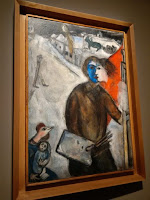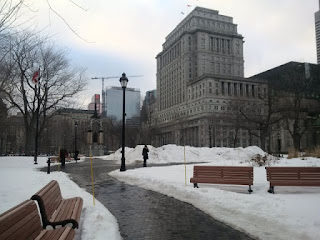 |
| Early self portrait showing Chagall's place of birth |
 |
| Le Rabbin de Vitebsk |
As an adolescent, he wanted to be a dancer, a poet, a violinist. The sound of the violin, to Chagall, was the voice of the Jewish soul. There's a "Fiddler on the Roof" in the painting entitled La Mort (a dead man lying on the street with candles around him, apparently a scene the artist remembered literally). Chagall was obsessed with images of violinists; he painted a Violiniste vert in 1923 (see below) and a Self portrait with violin, in 1954. On a Jewish wedding day, so it is said, the quality of the music reflects the quality of the marriage. Klezmer music is "the vessel of song" at Jewish celebrations.
 The Montreal exhibition includes a black-and-white video recording of a production of King Lear from the Jewish Theatre in the 1920s Soviet Union, starring its leading actor and director, Solomon Mikhoels. Chagall designed scenery and costumes for this theatre.
The Montreal exhibition includes a black-and-white video recording of a production of King Lear from the Jewish Theatre in the 1920s Soviet Union, starring its leading actor and director, Solomon Mikhoels. Chagall designed scenery and costumes for this theatre.Throughout his life, he painted entertainers, acrobats and dancers --- le cirque comme métaphore du monde! --- some of them headless or legless, floating in the air. Birds, pigs, horses and goats float through his paintings too, as if through a series of dreams. People appear with chicken's heads.
 |
| ... with 7 fingers |
 |
| Self portrait with Bella |
He etched illustrations for an issue La Fontaine's Fables around this time. From 1937 onwards, Chagall had French citizenship.
In Mannheim, in 1933, his works were condemned and burned by the Nazis as degenerate art and to escape the war and holocaust in Europe in the following decade he moved to America, to return to France in 1948, at which point he became involved with Jewish puppet theatre in Paris, recreating figures from the Shtetl of his youth (Yiddish for "little town"), creating Hakl-Bakl (i.e. "a little bit of everything") puppets.
 |
| Violiniste Vert |
 |
| Chagall's costume for Papageno, The Magic Flute |
1964 he designed the ceiling of Paris' L'Opéra and subsequently did paintings for the Met in New York (1966). While based in New York in the 1940s, he visited Mexico City, working with the production team for the ballet Aleko, New Mexico and Arizona too, where he discovered Katsina dolls that influenced his designs for the costumes. These were on display in the exhibition, as were his costumes for Mozart's opera, The Magic Flute. For New York productions of Stravinksy's Firebird ballet, too, he designed the scenery and costumes.
As an old man, in 1973, he revisted Russia. He died at the great age of 97.
At the museum, I spent a good two hours concentrating on Chagall's world, then came out to clear my head and walk around the city before catching my train home.




No comments:
Post a Comment